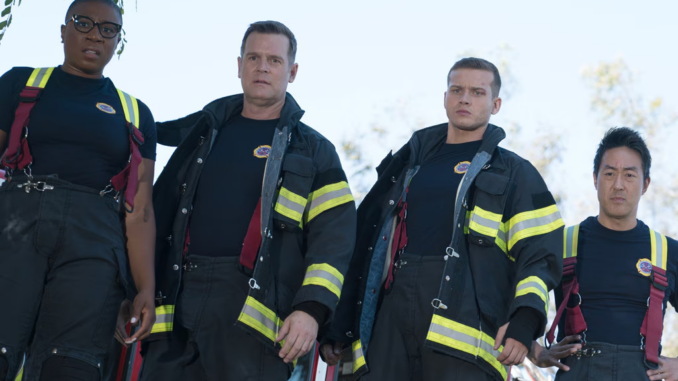
Fox’s drama starring Angela Bassett and Peter Krause is reaching new heights.
In today’s fragmented television landscape, a hit is rare. A broadcast hit that actually grows in its second season is even rarer, yet that’s just what Fox’s 9-1-1 has done. The season two premiere of 9-1-1 grabbed 13.8 million three-day multiplatform viewers and a big 3.4 rating in the 18-49 demographic during that same time period. Those numbers will likely go up when week-delayed DVR viewing is factored in. What makes 9-1-1 one of this year’s biggest hits?
There’s more than one reason why this drama about police officers, firefighters and the emergency dispatchers behind the scenes is coming out on top.
9-1-1 was created by TV masters Ryan Murphy, Brad Falchuk and Tim Minear. Murphy and Falchuk are familiar to TV audiences, from Nip/Tuck to Glee to American Horror Story. Minear, who is the showrunner on the series, has worked with Murphy and Co. on Feud and American Horror Story, and he’s also worked on some very beloved (albeit short-lived) shows including Firefly, Wonderfalls and Dollhouse. Minear’s other credits include Angel, Terriers and The X-Files. Viewers’ familiarity with their work makes 9-1-1 comforting. Plus, the varied TV experience works here because of just how bonkers 9-1-1 emergencies can be, which is also a draw for viewers. From babies in pipes to city-shaking earthquakes, 9-1-1 emergencies run the gamut—they’re plausible, sensational and gripping.
“A lot of our cases are real. In fact, the ones that probably you think, ‘Well, that never happened,’ are probably the ones that did happen. I mean, I even go back all the way to the pilot. A baby being flushed down some plumbing, that was a real thing. A bouncy house flying a hundred feet into the air, that was a real thing,” Minear told press at the 2018 Television Critics Association press tour. “So, we look to stories from real life. We originally started looking to YouTube a lot, because the whole feeling, our sort of esthetic for the show is it’s not sort of a plotty procedural. There are incidents, and we want it to sort of feel like the experience of getting onto YouTube and watching a compilation of ultimate fails. You keep clicking and going down that rabbit hole because you want to see the next cool thing. So that’s the experience that we’re creating for network television on a scaffolding of amazing, emotional character stories.”
